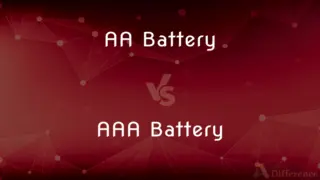SMTP vs. POP3 — What's the Difference?
By Tayyaba Rehman — Published on November 30, 2023
SMTP is a protocol for sending emails, while POP3 is used for receiving and storing emails on a client. Both are essential for email communication.

Difference Between SMTP and POP3
Table of Contents
ADVERTISEMENT
Key Differences
SMTP, or Simple Mail Transfer Protocol, primarily facilitates the dispatch of emails from a sender to the recipient. This protocol is responsible for ensuring that an email gets pushed from one mail server to another. When you send an email, SMTP handles the process, ensuring that the communication reaches its intended destination.
POP3, which stands for Post Office Protocol version 3, operates on the receiving end of email communication. Once the SMTP has done its part in sending the email, POP3 stores it until the end user retrieves it. This protocol fetches the email and holds it in the recipient's mailbox until they decide to view it.
SMTP and POP3 can be seen as two halves of the email communication process. While SMTP focuses on the delivery, POP3 handles the reception. It's essential to understand that while SMTP ensures the email gets to the correct server, it doesn’t handle getting it into the recipient's inbox - that's where POP3 steps in.
It's worth noting that SMTP and POP3 are not the only protocols for email communication. For instance, while SMTP can only send emails, and POP3 receives and stores, there's another protocol named IMAP (Internet Message Access Protocol) that can both receive and store emails, offering more synchronization flexibility across multiple devices.
Comparison Chart
Main Function
Sending emails
Receiving and storing emails
ADVERTISEMENT
Interaction with Mailbox
Delivers emails to the recipient's mail server
Retrieves emails from the server to the user’s device
Storage
Does not store
Stores emails locally after fetching them
Port Number
Uses port 25
Uses port 110
Association with Other Protocols
Often works with either POP3 or IMAP for email reception
Exclusively focused on email retrieval and storage
Compare with Definitions
SMTP
SMTP stands for Simple Mail Transfer Protocol.
SMTP ensures that emails are sent and delivered correctly between servers.
POP3
POP3 generally uses port 110 for its activities.
Ensure that port 110 is available and not blocked if you're setting up a POP3 service.
SMTP
SMTP works on a push mechanism rather than pull.
SMTP actively pushes the email forward until it reaches the destination server.
POP3
POP3 operates by fetching emails from the mail server for the end user.
Once the emails are fetched using POP3, they are typically deleted from the server.
SMTP
SMTP typically uses port 25 for its operations.
Make sure port 25 is open and accessible for SMTP to function properly.
POP3
POP3 is designed for users who need to access their email from a single location.
If you're using POP3, it's best to always access your emails from the same computer.
SMTP
SMTP operates by pushing emails to the recipient's mail server.
If there's an issue with SMTP, the email might not get delivered to its destination.
POP3
POP3 stores emails locally after retrieving them.
After downloading emails, POP3 ensures they're stored on your device.
SMTP
SMTP is the standard protocol for email transmission over the Internet.
To set up an email server, one must configure the SMTP settings appropriately.
POP3
POP3 is short for Post Office Protocol version 3.
POP3 downloads the emails to your device, making them accessible even offline.
Common Curiosities
Do SMTP and POP3 work on specific port numbers?
Yes, SMTP typically uses port 25, while POP3 operates on port 110.
How do POP3 and SMTP handle email storage?
SMTP doesn't store emails; it only sends them. POP3, on the other hand, retrieves emails and stores them locally.
Is SMTP secure?
SMTP itself is not encrypted, but it can be secured using protocols like TLS/SSL.
What happens to emails on the server once POP3 fetches them?
Usually, emails are deleted from the server after POP3 fetches them, but this can be configured differently.
What do SMTP and POP3 stand for?
SMTP stands for Simple Mail Transfer Protocol, while POP3 stands for Post Office Protocol version 3.
Are SMTP and POP3 the only email protocols available?
No, IMAP is another popular protocol that offers more features than POP3, especially for multi-device synchronization.
How do email clients interact with SMTP and POP3?
Email clients use SMTP to send out emails and POP3 to retrieve and store incoming emails locally.
How do SMTP and POP3 function together in email communication?
SMTP is responsible for sending emails, and POP3 handles the receiving and storing on the client's side.
Why might someone choose POP3 over other email retrieval protocols?
POP3 is simple and best suited for those accessing email from a single device, especially if offline access is crucial.
Can you use SMTP without POP3?
Yes, SMTP can be used without POP3, especially if another protocol like IMAP is used for receiving emails.
How does server location affect SMTP and POP3?
SMTP and POP3 servers' locations can impact email delivery and retrieval speeds, especially if there's significant geographical distance between them.
Is POP3 suitable for businesses?
While POP3 can be used by businesses, IMAP might offer more flexibility and features suitable for a business environment, especially with multiple users and devices.
Can both SMTP and POP3 be used on mobile devices?
Yes, both protocols can be used on mobile devices, though IMAP might be more suitable for users accessing email from multiple devices.
How do authentication mechanisms differ between SMTP and POP3?
Both SMTP and POP3 have authentication mechanisms, usually username and password, to ensure secure and authorized access.
Are there any modern alternatives to SMTP for sending emails?
SMTP remains the standard for email sending, though it's often secured and extended with additional protocols and mechanisms.
Share Your Discovery

Previous Comparison
AA Battery vs. AAA Battery
Next Comparison
Africa vs. South AfricaAuthor Spotlight
Written by
Tayyaba RehmanTayyaba Rehman is a distinguished writer, currently serving as a primary contributor to askdifference.com. As a researcher in semantics and etymology, Tayyaba's passion for the complexity of languages and their distinctions has found a perfect home on the platform. Tayyaba delves into the intricacies of language, distinguishing between commonly confused words and phrases, thereby providing clarity for readers worldwide.













































